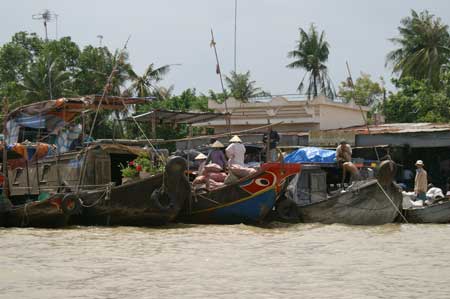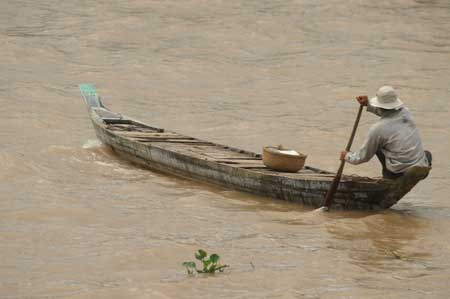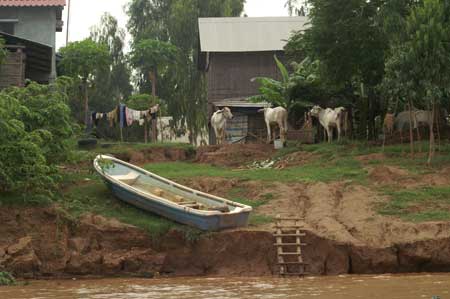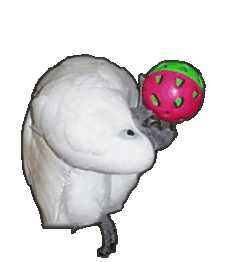Published Jul 21, 2006
I was going to the worst place in the world and I didn’t even know it yet. Weeks away and hundreds of miles up a river that snaked through the war like a main circuit cable - plugged straight into Kurtz.
No wait, sorry, wrong trip up the Mekong. Mine was actually kind of nice. No “terminate with extreme prejudice” or anything, although, you should be aware, this entry does not exist, nor will it ever exist.
After Saigon, my next stop was Cambodia — specifically, its capital, Phnom Penh, and the famous ruins at Angkor Wat. Now, I could fly up there, which was both quick and inexpensive (thank you Vietnam Airlines, Air Asia, and Bangkok Air!), but what fun would that be? No, I decided to take a tour up the Mekong river, seeing the sights and the local minority peoples and drinking with other English-speaking tourists. Yes, it promised to be a bang-up time.
(A note to my readers: this is how I write when I’m jet-lagged, apparently.)
We took a bus upriver from Ho Chi Minh — for some reason, none of the boats left straight from the city — and then caught a boat after a couple of hours of driving. The boat took us on a quick turn through the floating market at Chau Doc, a scenic assemblage of riverboats carrying all manner of products — I saw fish, and birds, and even someone motoring around offering cold drinks to the participants. Many people, it seems, live on the Mekong (I was told that there’s no property tax on the river, so it’s cheap to live there, although most families have done it for generations, probably since before any doi moi property-owning liberalization and taxation), and these floating markets are the way that people get their food and supplies and other sundries. The boats looked old but my guide said they were overhauled and repaired every year; the gray wood on their sides and peeling paint at the nose was just a side-effect of the general rot of the tropics.

From Chau Doc, we went up-river; first the Mekong opened up into a wide, placid body of water — it’s up to 10 km wide at points — and our boat crossed from one side to the other, cutting across the tracks of big, wooden, round-prowed cargo haulers, painted with the same red prow and big eyes that graced every boat on the Vientam end of the Mekong, supposedly to scare off the crocodiles that once infested the waters. Then the pilot took our big boat down a small inlet that split, invisibly, the jungle that lined the river. Everybody we passed on the inlet waved at us, even though we must’ve been the fifth boat that came by that morning. At the end of the inlet was a family making coconut candy and snake wine, clearly for tourist consumption; the took coconut milk and cooked it down into a tasty taffy, flavoring it with chocolate and leaves and nuts, then wrapping it in rice paper so that you could eat the entire, wrapped nugget. Snake wine is made from rice wine, with a cobra inside; it tastes like bourbon and has a little bit of an extra charge to it. Legend has it that two cups a day brings long life and enhanced sexual function.
Out of the inlet, further upriver, we stopped at a village selling candy made from puffed rice — it was remarkably like Rice Krispies treats — and then got on small rowboats to navigate a dense archipelago of square, three-walled houseboats that formed a city of fish farmers — each houseboat had a small farm inside, with room for the family to live. Past these we docked at a 40-foot pier, maybe two feet wide, made of the same rotten-looking gray wood as everything else; at the end was a Cham village. The Cham are a Muslim, Indian-influenced people who once ruled southern Vietnam, until the Viets took it away two hundred years ago. Now there are just a few thousand un-assimilated Cham in Vietnam, and we got to see them pray, sing, and sample their traditionally-woven cloth.
On the way back, our big Western asses broke the pier, sending half of it slowly tilting into the delta.
They switched us to a big boat, then, with a spacious top deck with comfortable chairs, and a nice, large, shaded lower deck. The only downside was getting onboard, over a narrow, long plank just about eight inches wide, schlepping our bags and ourselves on. But nobody fell, and, once onboard, we took quickly to the 50-cent “ba-ba-ba” beer from Saigon, stamped with its famous “333” crest (the letter 3 is, in Vietnamese, said something like “ba”). The Mekong opened up in front of us, big cranes lining its commercial width.

The night was spent at a cheap guesthouse, with a bar next-door that served food from an all-Vietnamese language menu with an all-Vietnamese-speaking staff. I was the only Westerner prepared to eat the fish-sauce-saturated food, a sad indictment of the backpacker culture.
The next day brought more river trip, as we got closer and closer to Cambodia; still, the river teemed with boats, small and large, and the Vietnamese were friendly and waved non-stop to us, every time they recognized a Westerner.

We stepped off the boat to walk across the border ourselves, here up where John Kerry supposedly illegally crossed the Cambodian border during the Vietnam war. On the other side of the border waited the smaller, beat-up Cambodian river boat. I was shocked to climb down the undeveloped bank — no pier this time, or even gangplank — and see a tour boat from the River Seine, rusty, peeling paint, looking hot in the direct sun. We piled inside, and they made some of us shift from the right to the left, as we had begun to list to the right with everyone avoiding the sun. Temperature climbed into the high-nineties in the poorly-ventilated boat, but the only option was to sit inside and bake, or on the top and be broiled, unsheltered from the mid-day sun.
Commerce on the river disappeared when we crossed the Cambodian border, with no large ships left, just a few canoes being paddled across the river. Villages became less dense, with large expanses of green on either side of the river, but suddenly cows were everywhere (later I would discover that cows were everywhere in the entire country, even all over the ruins of Angkor).

In the rickety boat, sweating off any residual pounds I kept from the twenty I gained in b-school, I actually began to appreciate the size of the Mekong. I can swim about a half mile without drowning, and I started worrying as the pilot weaved back and forth across the river, worrying how far I would have to swim if the Seine Cruiser went down. The Mekong was a deep brown and looked thick and silty enough to plow. The Cambodians were as friendly as the Vietnamese, and every person we passed waved.

Upriver, they piled us onto an even more rickety minibus, with the seats perched on top of cinderblocks (actually, we never would have made it away from the landing spot, had not the Israeli memeber of our group started making a stink, because the bus-driver wanted to wait for us to buy pate sandwiches, made on stale baguettes, sold by an old lady at the landing). Half of the group was piled into a brand new-looking minibus, and we were jealous until the radiator on that vehicle spectacularly exploded, sending jets of coolant spraying below and behind the bus. Somehow the Cambodians patched it and we made our way on to Phnom Penh, where they tried to drop us at a guest house in the middle of nowhere. I asked to see a bathroom and was, instead, taken on a tour of the premises; when I hopped into a tuk-tuk and headed off to my hotel, I assume I cost someone money, either depriving the tour operators of a commission or making the hotel operators pay a commission on someone who didn’t stay. Either way, I appreciated causing the inconvenience.

I guess the cobra in snake wine is sorta like the worm in tequila?